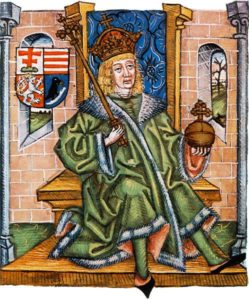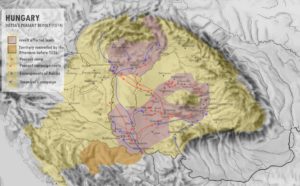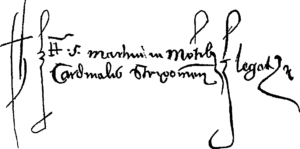Cardinal Bakócz Tamás (1442-1521)
Bakócz Tamás (Erdőd, 1442 – Esztergom, 15 June 1521), a variant of the name Bakács Tamás, Dominican priest, cardinal, bishop of Győr, then of Eger, later archbishop of Esztergom, nominal patriarch of Constantinople. For decades he was one of Hungary’s greatest dignitaries. He was the only Hungarian priest who had a serious chance of becoming Pope. (Please, note that I use the Oriental name order for Hungarians where family names come first.)

His father, Bakócz Ferenc, was a serf of the Drágffy family in Erdőd, Szatmár county, and had five sons. He probably worked as a wheel maker, at least as the wheel on the coat of arms donated to Bakócz Bálint, the provost of Titel, seems to indicate. Note, Titel was a very wealthy place at that time. Bakócz Bálint, the brother of Bakócz Tamás, entered the priesthood, progressed with the support of Palatine Ország Mihály, and inherited the wealthy Titel priory from Janus Pannonius when he became bishop of Pécs. Tamás’ studies and priestly career were initially supported by his brother Bálint.

He studied in Németi (Satu Mare), at the Dominicans, then in Boroszló (Wrocław) and Padua. In 1464 he obtained a doctorate in philosophy in Krakow. From there he went with his brother Ferenc to the college in Ferrara. During his studies, he used the name Erdődi Tamás.
He returned home around 1470. Through the mediation of his brother or Guarino of Ferrara, he came into the entourage of Rangoni Gábor, Bishop of Transylvania, and through him, he got close to King Matthias Corvinus. During Matthias’s campaign in Silesia in 1474, he attracted the king’s attention by giving military advice that turned a crisis to the advantage of the Hungarian monarch. You can read more about the Silesian wars of King Matthias here:
https://www.hungarianottomanwars.com/essays/king-matthias-at-boroszlo-wroclaw-breslau/

Initially, he was given only modest chancellor’s posts as a clerk and draftsman. Between 1475 and 1480 he accompanied Matthias on his three campaigns against the Turks and on the campaign to conquer Austria. He was one of King Matthias’ trusted advisers. Bakócz always had a great sense of how best to adapt to changes in the political situation. In 1480 Bakócz Bálint granted him the priesthood of Titel (he was without a job for a while, then he accepted the parish of Sárospatak). He soon became royal secretary to Matthias, deputy to the royal chancellor. In 1486, while retaining his titular dignity, he was appointed Bishop of Győr and was given the rank of royal councilor.

After Matthias’ death, he first supported János Corvin’s candidacy for the throne. However, King Ulászló II (Jagelló) who succeeded Matthias supported him by promising him the title of chancellor-general. Upon accepting this office in 1490 he became the king’s chancellor. Between 1493 and 1499 he was one of the crown guards.

In 1493 or 1494 he won the episcopate of Eger, which was one of the richest Hungarian episcopal benefices. In the same year, he made a deal with Cardinal Estei Hippolit, with whom he exchanged positions, and was elevated to Archbishop of Esztergom, Primate of Hungary. However, Bakócz’s political and ecclesiastical ambitions extended far beyond the borders of the medieval Kingdom of Hungary.

The first decisive change in his international advancement came when, in 1500, with the support of Venice, he was appointed cardinal and, ten years later, Patriarch of Constantinople (the latter title was nominal since Rome had no real ecclesiastical organization in Constantinople; however, the holder of the title was considered the second highest ranking high priest after the Pope). This inevitably brought Bakócz into the war raging over Italy, and he often had to balance the ever-changing coalitions.

On 21 February 1513, Pope Gyula (Julius) II died, and this tragic event raised the possibility of a Hungarian high priest winning the papal throne. He was the first and, until 2013, the only Hungarian with a serious chance of becoming Pope. But the most senior members of the College of Cardinals seemed to have a better chance. In particular, Cardinal Giovanni de’ Medici was extremely popular, not only among the cardinals but also among the Roman population. Also, he was supported by the loan of the wealthy Fugger bankers.

Yet Archbishop Bakócz also lobbied hard, making no secret of his promise that, if elected, he would devote his vast fortune to organizing a crusade against the Turks. The papal election was attended by 25 cardinals, 18 of Italian nationality, three Spanish, and one of English, French, Swiss, and Hungarian nationality. Voting began on 10 March, but in the first round, none of the candidates obtained the necessary two-thirds majority. In the end, the young Italian cardinals decided on the issue. In Giovanni de’ Medici, they also saw a patron of the arts with the potential for peaceful development. The result was achieved that very evening. The new Pope Medici took the name Leo X and was formally enthroned on 19 March 1513.

Later that year, Bakócz returned to Hungary as papal legate, bringing with him Pope Leo X’s bull proclaiming a crusade against the Turks. In the Diet, he succeeded in having the Crusade declared in the country on 16 April 1514, in violation of the three-year peace treaty with Sultan Selim I. This soon led to the outbreak of the peasant revolt led by Dózsa György, which set the whole country aflame. Let me note, that the 40,000 peasants at Pest began to rebel because the money that was sent from Rome for their support never arrived. Who stole the money? One might ask whether a successful anti-Ottoman crusade could endanger the position of the next applicant for the papal throne, giving too much fame and success to Bakócz…

As the indirect instigator of the uprising, Bakócz was much reproached. To cover up his luxurious lifestyle, he placed the bishopric of Milkó and the Deanery of the Saxons under the Archbishopric of Esztergom, provoking the discontent of the latter, which was later a major cause of the spread of the Reformation among the Saxons.

After the death of King Ulászló II (1516), his influence at the royal court weakened. He suffered from severe gout and in 1519 he suffered a stroke and withdrew from state affairs altogether. He is buried in the Bakócz Chapel of the Esztergom Basilica, which he had built.

Source: the Hungarian Wikipedia
Dear Readers, I can only make this content available through small donations or by selling my books or T-shirts.
If you like my writings, please feel free to support me with a coffee here:
You can check out my books on Amazon or Draft2Digital, they are available in hardcover, paperback, or ebook:
https://www.amazon.com/dp/198020490X
or at https://books2read.com/b/boYd81


My work can also be followed and supported on Patreon: Become a Patron!http://Become a Patron!


https://hungarianottomanwars.myspreadshop.com/all




